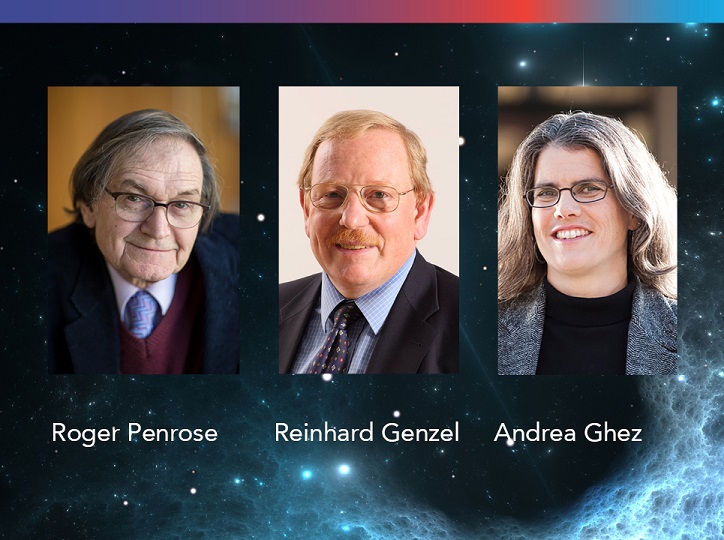About
06 October 2020
Roger Penrose, Reinhard Genzel and Andrea Ghez Awarded 2020 Nobel Prize in Physics
The Supermassive Black Hole Discovery Enabled by Adaptive Optics
WASHINGTON – Three scientists – Roger Penrose, Reinhard Genzel and Andrea Ghez – have been awarded the 2020 Nobel Prize in Physics for their discoveries involving the “darkest secrets of the universe.”
Roger Penrose, Emeritus Rouse Ball Professor of Mathematics at the University of Oxford, UK, was recognized "for the discovery that black hole formation is a robust prediction of the general theory of relativity.” The other half of the physics prize was awarded jointly to Reinhard Genzel, Acting Director, Max Planck Institute for Extraterrestrial Physics, Germany and University of California, Berkeley, USA; and Andrea Ghez, Professor of Physics and Astronomy, University of California, Los Angeles, USA "for the discovery of a supermassive compact object at the center of our galaxy."

Caption: 2020 Nobel Laureates in physics Roger Penrose, Reinhard Genzel and Andrea Ghez
The observations of Genzel and Ghez were enabled by infrared speckle imaging and, subsequently, adaptive optics. They used high spatial resolution imaging techniques such as the adaptive optics system at the Keck Observatory telescope and the European Southern Observatory’s Very Large Telescope. The telescopes have near-infrared instruments that allowed observations through interstellar dust and an adaptive optics system that compensated for the turbulence of the atmosphere, enabling the observation of stars orbiting around the galactic center. The use of adaptive optics dramatically shortened the exposure time needed for the observations.
“The contributions of adaptive optics in providing a razor-sharp view of the cosmos have been critical to these extraordinary discoveries,” said Stephen Fantone, 2020 OSA President. “The pioneering work on real-time active correction of telescope optics and the use of laser guide stars were among the many optical developments that have revolutionized the tools of modern astronomy.”
Ghez is the fourth woman to win a Nobel Prize in Physics. Nobel Laureate and 2013 OSA President Donna Strickland, the third woman to win a Nobel Prize in Physics, shared the 2018 prize with OSA member Gérard Mourou for groundbreaking discoveries in the field of laser physics. They were honored for “their method of generating high-intensity, ultra-short optical pulses.” The late Arthur Ashkin was also awarded the physics prize that year for inventing optical tweezers that use laser fields to move particles, atoms, viruses and other living cells in studying biological systems. To date, 38 OSA members have been awarded a Nobel Prize in Physics, Chemistry or Physiology or Medicine.
To learn more about the role of infrared telescopes and adaptive optics in the award-winning discoveries, read the story at Optics & Photonics News.
About The Optical Society
The Optical Society (OSA) is dedicated to promoting the generation, application, archiving, and dissemination of knowledge in optics and photonics worldwide. Founded in 1916, it is the leading organization for scientists, engineers, business professionals, students, and others interested in the science of light. OSA’s renowned publications, meetings, online resources, and in-person activities fuel discoveries, shape real-life applications and accelerate scientific, technical, and educational achievement.
Media Contact
